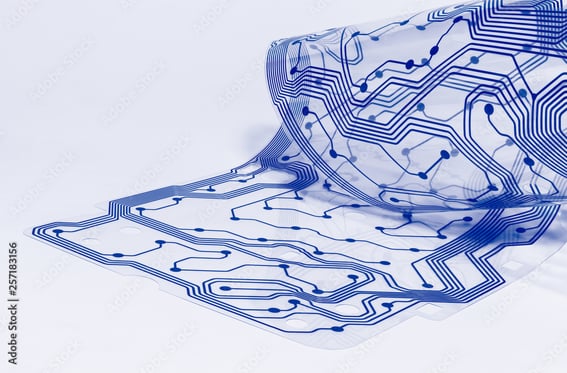Material compatibility and sourcing becomes increasingly complex when scaling up printed electronics production. Because materials (substrates, conductive inks, dielectrics, hydrogels) are the building blocks of printed electronic components, ensuring a consistent, reliable supply of high-quality materials is essential for successful large-scale manufacturing.
Let’s go through a few areas you’ll want to pay attention to as you transition to higher volumes.
Material Selection & Compatibility:
Start by selecting materials that are well-suited for the specific printing processes and equipment you plan to use in mass production. Conduct thorough material compatibility testing during the prototype phase to identify potential issues early. This includes testing the compatibility of conductive inks, substrates, and dielectric materials with your chosen printing technology and curing methods.
- Conductive Inks: Conductive inks are a fundamental piece of printed electronics, used to create conductive traces, electrodes, and components. Scaling up production demands a significant volume of ink and ensuring the compatibility of these inks with the printing process, substrates, and curing methods is crucial. Material properties such as viscosity, resistance, particle size, and adhesion must be well-matched to the chosen printing technology and substrate material. Other process parameters will also be driven by the ink characteristics – screen mesh, working time on screen, curing time and others.
- Substrates: Substrate materials provide the foundation for printed electronics. When moving from low volumes to mass production, it's important to select substrates that are well suited for the printing process and desired end-use applications. Factors such as substrate thickness, sheet size, flexibility, surface treatment and any requirement for pretreatment can impact the quality and performance of printed components.
- Dielectric Materials: In addition to conductive inks, dielectric materials are used to create insulating layers in printed electronic devices. You’ll want to be certain of the compatibility between your dielectric materials and conductive inks for proper electrical isolation and functionality.
- Hydrogels or hydrocolloids: This can be a critical feature for medical wearables using printed electronic technology. The assembly process can be driven by the material selection. For example, some are pour and cure only. Others are available in sheet form for die cutting. Each has their advantage. Key characteristics to consider when ramping volumes are shelf-life, roll size, cure times and general supplier support.

Material Sourcing:
Supply Chain Reliability: Increasing your volume leads to higher demand for materials, which can strain the supply chain. Manufacturers must establish a reliable and robust network of suppliers to avoid disruptions caused by material shortages or delays. The best strategy is to source materials from multiple suppliers or regions to mitigate risks. Multiple suppliers can provide redundancy and flexibility in case one supplier encounters production issues, there are unforeseen environmental disasters, or logistics roadblocks. Possibly the biggest challenge needs to be addressed early in the development process and that is dual sourcing. The OEM must be convinced early on that it is important to spend the time and effort to test, validate and qualify two sources of supply. In some cases, this is critical.
Quality Assurance: Variations in material quality can lead to inconsistencies in printed electronic components. To avoid this, work with your supplier network to establish quality assurance protocols, conduct regular material testing, and ensure materials meet required specifications. Create a process for rejecting non-conforming materials to prevent them from entering the production line and causing issues.
Cost Management: It shouldn’t come as a surprise that scaling up production can lead to increased material costs. Manufacturers need to balance the need for high-quality materials with cost-efficiency. Negotiating favorable contracts with suppliers, exploring bulk purchasing options, and optimizing material usage are strategies to manage costs effectively.
Material Specification Documentation: Develop and/or review detailed material specification documents that outline the required properties of each material used in the production process. Materials manufacturers typically have very detailed specs. You’ll need to understand which are important to your application and be sure both you and the supplier have controls in place to manage these. These specifications should cover parameters such as viscosity, particle size distribution, adhesion characteristics, and electrical conductivity, although your requirements could vary. Share these with suppliers to make sure they clearly understand what is critical to your process.
.png?width=488&height=366&name=MicrosoftTeams-image%20(81).png)
Addressing the challenge of material compatibility and sourcing requires a multidimensional approach that encompasses material selection, supplier relationships, quality control, and cost management. Successful large-scale printed electronics production hinges on a well-structured and robust material strategy that ensures a steady and consistent supply of materials while meeting quality and sustainability standards. Collaboration between manufacturers and material suppliers is often key to finding innovative solutions to these challenges.
By working with a manufacturer who is experienced at implementing these solutions, you can mitigate many of these growing pains, making for a smoother transition from prototypes to mass production while maintaining high-quality, reliable products. Collaboration, thorough testing, and robust quality control are key elements in this process.




.jpg?width=176&height=56&name=MR_associatedNetwork_logo%20(1).jpg)